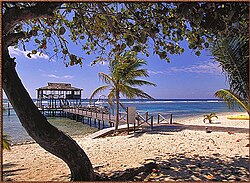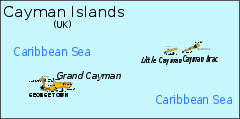Cayman Brac
| Cayman Brac | |
 Brac Beach Resort | |
|---|---|
| Location | |
| Location: | 19°43′0″N 79°48′0″W |
| Area: | 15 square miles |
| Highest point: | The Bluff, 140 feet |
| Data | |
Cayman Brac is an island amongst the Cayman Islands in the Caribbean Sea. It is the westernmost of the three main islands, lying 90 miles northeast of Grand Cayman and 5 miles east of Little Cayman. Cayman Brac is about 12 miles long, with an average width of 1 mile.
The terrain of Cayman Brac is the most prominent of the three Cayman Islands due to "The Bluff", a large central limestone outcrop that rises steadily along the length of the island up to 140 feet above sea level at the eastern end, which provides the highest point in the territory. The island is named after the Bluff; as "brac" is a Gaelic name for a bluff.
History
Christopher Columbus sighted Cayman Brac and its sister island, Little Cayman, on 10 May 1503 when his ship was blown off course during a trip between Hispaniola and Panama. He named them "Las Tortugas" because of the many turtles he spotted on the islands. The Cayman Islands were renamed by Sir Francis Drake, who came upon the islands during a voyage in 1586. He used the word "Caymanas", taken from the Carib name for crocodiles after seeing many of the large crocodilians. Many people believe he had only seen the rock iguanas that inhabit the island today.
During the high days of piracy in the West Indies, pirates would use Cayman Brac as a haven and a place to replenish their supplies as there are a number of fresh water wells on the island and had many sources of food included in the local flora and fauna.
In 1969 Donald Crowhurst attempted to sail round the world single-handed in the Teignmouth Electron, taking part in the in the Sunday Times Golden Globe Race. After his death at sea, understood to be suicide, the Teignmouth Electron washed ashore at Cayman Brac and has been left to decay on the south coast.
Attractions
Diving
Of interest to scuba divers is a 330-foot Soviet Koni class frigate, built in the Soviet Union in 1984 for the Cuban Navy. It is one of only a few sunken Soviet naval vessels in the Western Hemisphere, and the only one that is easily dived. The Koni II class frigate was purchased and sunk by the Cayman Islands government in September 1996. Originally designated 356, the frigate was rechristened the M/V Captain Keith Tibbetts, after a well-known Cayman Brac politician. The wreck originally sat upright in approximately 90 feet[1] with the deck at 60 feet, until wave action generated by a winter Norwester storm (December 1998-January 1999)[2] which nearly tore the ship in two. The result was that the fore section tipped to about a 45 degree angle in relation to the remainder of the still-upright aft portion.[3] and the midships became a debris field. The wreck's stern area was essentially unaffected. The frigate is located in a sandy area with generally good visibility, approximately 220 yards offshore (a fairly long swim) from 'Buccaneer', on the island's north side, near the western tip of the island. There are numerous openings in the upper portion of the ship for non-wreck certified divers. Many more openings are available since the ship broke in half. The site also serves as an artificial reef. Other interesting dive sites are Radar Reef, Cemetery Wall, and the Wilderness Wall [4], all well covered in corals and with a wide diversity of marine life.
Caves
Caves are found around the island, offering cavers a glimpse of delicate underground formations. Steps and, in some cases, ladders have been constructed to allow visitor access to more remote caves. One cave, Rebecca's Cave,[1] contains the grave of a young girl lost in a struggle against the ravages of the great '32 Hurricane, and it is a Cayman National Heritage Site.
Rock Climbing
Though the island is not lofty; the Bluff reaches just 140 feet above the sea, it has gained a reputation for rock climbing. This was developed beginning in 1992 and the island is now known as a world-class climbing destination. One must be somewhat experienced to climb here as the terrain is steep, many times over-vertical.
Walking and Hiking Trails
Walking and hiking trails have been opened by the Nature Tourism Programme which allow exploration of the island's dense Karst forestation. Unique flora and fauna thrive here and can be observed in the wild.
Fishing
Cayman Brac's waters are especially utilized for both fishing and the pursuit of big game fish.
Local Economy
The local economy tends to be concentrated in three areas which are probably typical for many Caribbean locales: tourism, municipal government, and local enterprises, although on the Brac, the government (including Cayman Airways, the National carrier) is the largest employer. Some of the more economically prominent families in Grand Cayman originate from Cayman Brac, namely the Kirkconnells, Fosters, Waltons, and Scotts. The majority of the tourism sector is concentrated on scuba diving, although this is in recent decline in the hospitality sector, with one of the two local hotels, Divi Resorts, closed operations in 2006.[5] The island's economy was also adversely impacted by significant damage from Category 4 Hurricane Paloma in November 2008.
A local enterprise that is nearly unique to Cayman Brac are its artists who work in a local stone known as Caymanite, typically making jewelry or small stone carvings. For the 2011 Wedding of Prince William, the official gift from the Islands was crafted by Horacio Esteban,[6] who grew up on Cayman Brac and is currently living on Grand Cayman.
Outside links
- Cayman Brac's website
- Cayman Brac's 360° Virtual Tours
- Attractions, photographs and much more information on Cayman Brac
- pictures and a brief bit of history regarding a unique form of crochet that developed on Cayman Brac
- 2005 Photo of the Teignmouth Electron on Cayman Brac
References
- ↑ Original Upright 356 Bow UW photo of the 356 Bow (Sept 1996), from huntzinger.com
- ↑ Sport Diver Magazine, April 1998, page 11
- ↑ Tipped-over 356 Bow UW photo of the 356 Bow (Sept 2000), from huntzinger.com
- ↑ GDS Dive Directory Dive Sites Cayman Brac
- ↑ Closure of Divi Tiara Beach Resort, of Divi Resorts as reported by Caymannetnews.com
- ↑ 26 April 2011 Cayman27 News Story
- Skip Harper (2002). Adventuring on Cayman Brac: A Guide to Great Adventures on this Small Caribbean Gem. Heel and Toe Publishers. ISBN 0-9640645-2-9.
